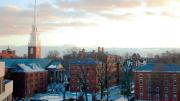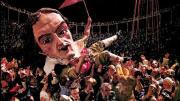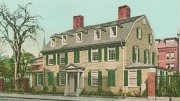A 375th anniversary is not a 350th (sorry, Anglophiles: no keynote by HRH Prince Charles this time), nor a 400th (likely to be a real and virtual humdinger)—but neither is it chopped liver. To have survived since 1636 is no small thing. To thrive, when going on four centuries, merits observation and, even at this relatively austere moment, celebration. And so the University observes and celebrates in a community get-together on October 14, converging on Harvard Yard (details at https://375.harvard.edu).
Twenty-five years ago, Harvard Magazine embraced the 350th with a 256-page issue, the largest in its history. Given that issue’s enduring value as an exploration of the events and people who had made the University what it was then, and in many ways shaped what it is today, we have made two basic decisions:
- First, we have put the entire September-October 1986 issue online at harvardmag.com/375th, as an aid to memory for readers then and an invitation to discovery for the nearly quarter-million alumni, faculty, and staff members who receive the magazine bimonthly today—plus the countless readers of harvardmagazine.com worldwide.
- Second, we have focused our efforts in this new issue on the University’s eventful past quarter-century, and its prospects as it nears its quadricentennial.
In our reporting, we have examined significant changes in the life of this restless and rooted institution: in the University itself, in the faculty ranks and student bodies, and in the physical campus that supports their learning, teaching, and research. We have asked graduates how their education did (or did not) prepare them for the lives they have lived, and what they would want in a Harvard education beginning today. We have asked a few members of the faculty—from an impossibly large number of candidates—to outline the challenges and opportunities they see in their disciplines; they have responded with the expected degree of passion and insight, and more besides. We reached out to interesting and accomplished people from around the world to solicit their visions of Harvard’s role and nature in 2036. And to inject an appropriate note of humility, we looked back at the forecasts and predictions, explicit or implied, from the 350th anniversary issue, to see how well the crystal balls worked in that distant, predigital era.
We note with special thanks a gift from a donor who wishes to remain anonymous, to support publication of this special, expanded anniversary edition of Harvard Magazine.
Finally, much as Harvard itself embeds innovation and change within one of the longest-lived and most traditional of institutions, the magazine aims to anchor its reporting on the place and its people in proven principles and in meaningful memories about the institution and its values. So it is a special pleasure to note that John Bethell, Christopher Reed, and Jean Martin (respectively editor, managing editor, and associate managing editor in 1986), and long-time contributing photographer Jim Harrison and artist Mark Steele, who did so much to create that monumental 350th anniversary issue, were all still engaged in preparing this successor magazine for you today.











